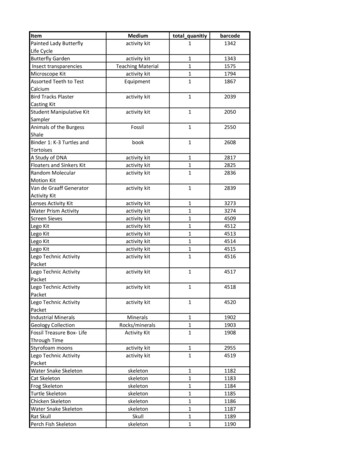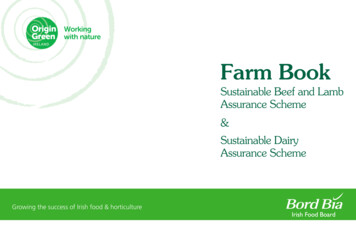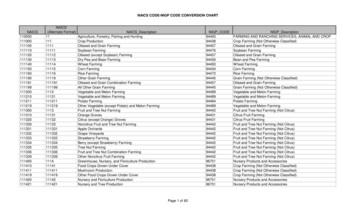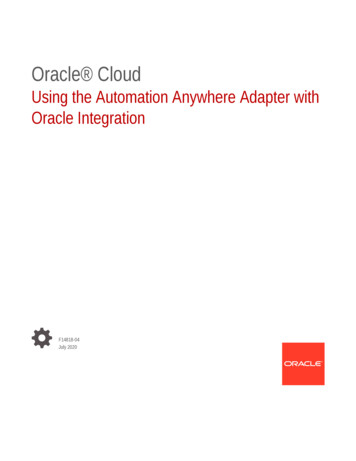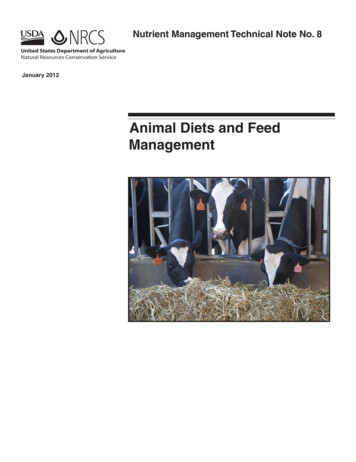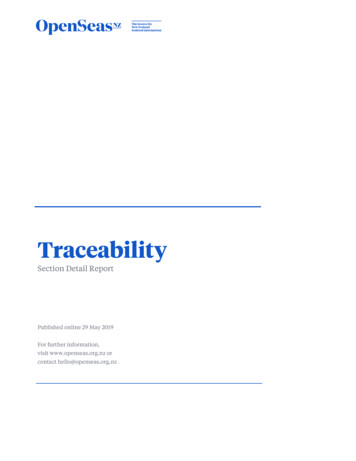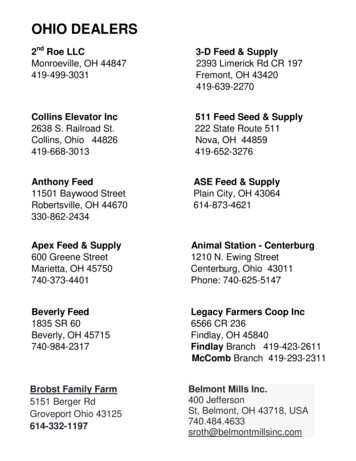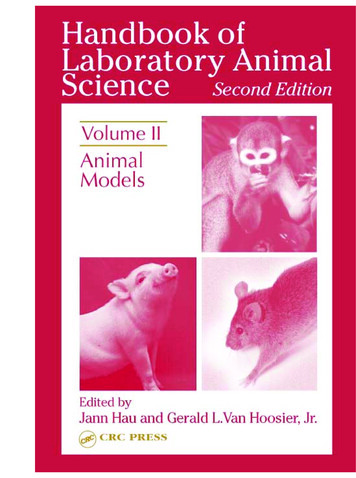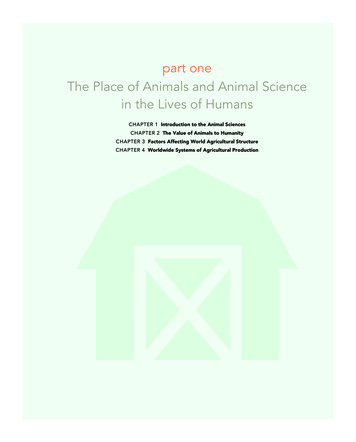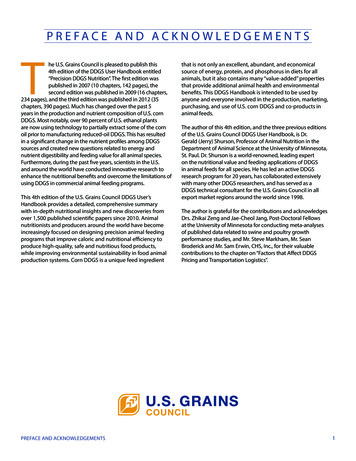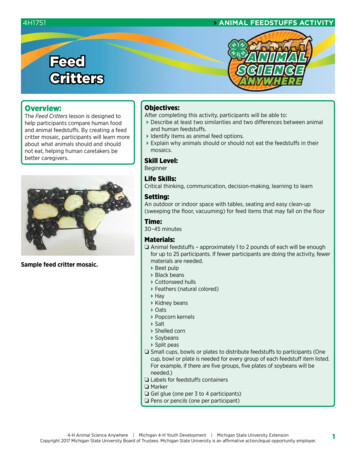
Transcription
4ANIMAL FEEDSTUFFS ACTIVITY4H1751FeedCrittersOverview:The Feed Critters lesson is designed tohelp participants compare human foodand animal feedstuffs. By creating a feedcritter mosaic, participants will learn moreabout what animals should and shouldnot eat, helping human caretakers bebetter caregivers.Objectives:After completing this activity, participants will be able to: Describe at least two similarities and two differences between animaland human feedstuffs. Identify items as animal feed options. Explain why animals should or should not eat the feedstuffs in theirmosaics.Skill Level:BeginnerLife Skills:Critical thinking, communication, decision-making, learning to learnSetting:An outdoor or indoor space with tables, seating and easy clean-up(sweeping the floor, vacuuming) for feed items that may fall on the floorTime:30–45 minutesMaterials:Sample feed critter mosaic. Animal feedstuffs – approximately 1 to 2 pounds of each will be enoughfor up to 25 participants. If fewer participants are doing the activity, fewermaterials are needed. Beet pulp Black beans Cottonseed hulls Feathers (natural colored) Hay Kidney beans Oats Popcorn kernels Salt Shelled corn Soybeans Split peas Small cups, bowls or plates to distribute feedstuffs to participants (Onecup, bowl or plate is needed for every group of each feedstuff item listed.For example, if there are five groups, five plates of soybeans will beneeded.) Labels for feedstuffs containers Marker Gel glue (one per 3 to 4 participants) Pens or pencils (one per participant)4-H Animal Science Anywhere Michigan 4-H Youth Development Michigan State University ExtensionCopyright 2017 Michigan State University Board of Trustees. Michigan State University is an affirmative action/equal opportunity employer.1
4ANIMAL FEEDSTUFFS ACTIVITYPROCEDURE:Materials, Continued Copies of animal outlines for mosaic(Each participant will choose one animalso print off extras since you will notknow ahead which they will choose.) Beef cow Chicken Dairy cow Goat Horse Llama Pig Sheep “Feed Critter” worksheet (one perparticipant) Cardstock (optional)Before the meeting:1. Review the lesson and verify you have all the supplies. You maywish to copy the “Feed Critter” worksheet on cardstock.2. Become familiar with terms that will be helpful for you and theparticipants to know for this lesson (consumption, feedstuff,caretaker, caregiver).3. Make a sample mosaic to show as an example to the participants.4. Create a supply table. Each group will pick up its own supplies:feedstuffs in labeled containers, gel glue, and a pen or pencil foreach group member. Make sure to label the containers to helpguide the participants.5. Gather a few volunteers to help with each group to answerquestions and assist with gluing.Table 1. Feed Items Used, Nutritional Component of the Diet and Animal(s) That Consume(s) This ItemItemNutritionalcomponent ofthe dietAnimal(s) that consume(s) this itemBeet pulpFiberBeef and dairy cattle, pigs, goatsBlack beansProteinNot a feedstuff for animalsCottonseed hullsFat and fiberBeef and dairy cattle, pigs, sheepFeathers (natural colored)ProteinChickensHayFiberBeef and dairy cattle, pigs, sheep, goats, horses, llamasKidney beansProteinNot a feedstuff for animalsOatsEnergyBeef and dairy cattle, pigs, sheep, goats, horsesPopcorn kernelsEnergyNot a feedstuff for animalsSaltMineralBeef and dairy cattle, pigs, sheep, goats, chickens, horses, llamasShelled cornEnergyBeef and dairy cattle, pigs, sheep, chickens, horses, goatsSoybeansProteinBeef and dairy cattle, pigs, sheep, goats, chickensSplit peasProteinNot a feedstuff for animalsDuring the meeting:1. Introduce the activity by reading aloud or paraphrasing thefollowing:Knowing what an animal needs to eat is important to makesure it stays healthy and productive. Just as humans do,animals under our care require a balanced diet to maintainhealth and an active lifestyle. There are some food items thatboth humans and animals eat. There are also items that onlyhumans consume or items that only animals consume. Today,we are going to take a closer look at what feedstuffs animals24-H Animal Science Anywhere Michigan 4-H Youth Development Michigan State University ExtensionCopyright 2017 Michigan State University Board of Trustees. Michigan State University is an affirmative action/equal opportunity employer.
4ANIMAL FEEDSTUFFS ACTIVITYeat and how they compare to human foods by creating afeed critter mosaic.2. Divide participants into small groups of three or four individuals toshare resources.3. Read aloud or paraphrase the following:A mosaic is a picture or pattern that is created by using smallpieces of various materials (glass, paper, beads, beans andother items) to create the bigger image. The image you willmake is of an animal. You will create a feed critter mosaic.4. Hold up your example mosaic. Read aloud or paraphrase thefollowing:This is just one example of what your animal could look like.To get started, each of you will choose an animal design forthe feed critter mosaic. Start by choosing an animal youwould like to learn more about. There are several optionsfor you to explore. You can pick one you are already familiarwith or one that you might not know a lot about. Once youhave selected your animal, look at the food items on thetable. You will be using these items to make your feed crittermosaics. All the items are labeled to let you know what theyare. Once you have all of your supplies, you can begin gluingthe feedstuffs on your animal outline by placing glue whereyou would like a feedstuff to stick.5. Take mosaic outlines around to participants and allow them toselect their animals.6. Have a participant from each group come to the supply table andgather their feedstuffs.7. Allow participants time to create their feed critter mosaics onthe animal outline. Participants should apply glue to the paperwhere they want the feedstuffs to stick. Allow them approximately10 minutes to complete this portion. While participants work,distribute one “Feed Critter” worksheet to each.8. Read aloud or paraphrase the following:If you have not already finished your mosaic, add yourfinishing touches. You will then glue the mosaic onto the“Feed Critter” worksheet.9. After participants finish their feed critter mosaics, each should gluehis or her mosaic onto the “Feed Critter” worksheet. It will workbest for participants to put the glue on the worksheet and thenplace their mosaic creation onto the glued area of the worksheet.10. Read aloud or paraphrase the following:In your group, help each other to answer the four questionson the worksheet. Write your answers down in theappropriate places.4-H Animal Science Anywhere Michigan 4-H Youth Development Michigan State University ExtensionCopyright 2017 Michigan State University Board of Trustees. Michigan State University is an affirmative action/equal opportunity employer.3
4ANIMAL FEEDSTUFFS ACTIVITY11. Provide participants 5 minutes to answer the questions. Duringthat time, walk around to the groups to make sure that they areanswering the questions. After 5 minutes, have participants sharetheir answers to the four worksheet questions in their small groups.12. Have participants help clean up extra supplies and work areas.13. Bring participants back to one large group. As a group, review theworksheet by using the guide below to help encourage participantdiscussion. You are also encouraged to use the “Talking It Over”questions to help participants process the lesson. What feedstuffs did you use? (Corn, oats, hay and otherfeedstuffs) Why did you pick that choice? (color, texture, knowing this is partof the animal’s diet and other reasons) Why would your animal eat these items? (to grow, they tastegood, to remain healthy, to build muscle, to keep the rumenmicrobes healthy and other reasons) Why is it important that animals don’t eat some of the foods thathumans eat? (too sweet, poisonous, not healthy for the animal,the animal can’t digest it and other reasons) What can you do to improve how you take care of animals youmay have at home? (feed them consistently, make sure theyare eating the correct feeds, make sure they are eating the rightamount of feeds and other ideas)14. To summarize, read aloud or paraphrase the following:The feed critter mosaic helped you to creatively exploreanimal feedstuffs. Knowing what an animal eats is importantfor you to know as an animal caretaker to ensure animalsstay healthy and grow or produce as we expect. Recognizethat humans and animals eat many of the same foods suchas corn, oats or beets, but these items may be in differentforms. There are items animals can eat that humans cannot,such as cottonseed hulls. Knowing what feedstuffs areappropriate for animals will help keep them healthy.Talking It Over:Ask the group the following questions. Would you design your mosaic differently now that you know whatyour animal eats? Which items are foods both people and animals eat? Do they lookthe same or are they different? What jobs could you explore that are related to this lesson? Where could you find more information about jobs or careersrelated to today’s lesson?44-H Animal Science Anywhere Michigan 4-H Youth Development Michigan State University ExtensionCopyright 2017 Michigan State University Board of Trustees. Michigan State University is an affirmative action/equal opportunity employer.
4ANIMAL FEEDSTUFFS ACTIVITYADAPTATIONS & EXTENSIONS:For Older or More Experienced Participants: Have participants pick a different animal other than those listed.Draw or trace the silhouette and then complete the mosaic. Thisallows youth an opportunity to learn something new about anotherspecies they are unfamiliar with. Also, have older youth share factsabout the animals they choose with younger participants, such aswhat other animals eat, where they live, how long they live andsimilar facts. Have more experienced participants pair up with a lessexperienced participant to work together on the activity. Have themore experienced youth explain what each feedstuff is and how itis used by the body. Using the same feedstuffs, have participants prepare what they feelis a balanced diet and include those proportions in the mosaic.For Younger or Less Experienced Participants: Have everyone work as a group, deciding on one animal to workon and discuss the answers to the questions as a group. A differentanimal could be done at several different meetings so participantslearn over a period of time about what various animals eat,introducing them to new species.ALIGNMENT TO SCIENCE AND ENGINEERING PRACTICES:How does 4-H increase science literacy?Nationally and in Michigan, 4-H has long enjoyed a reputation for engaging young people in positive, experiential(hands-on), and nonformal activities that are inquiry-based. The lessons in the 4-H Animal Science Anywhereseries can be used to enhance classroom science education. The lesson activities are aligned with the eightScientific and Engineering Practices from A Framework for K–12 Science Education (National Research Council,2012, p. 42).The activities in the 4-H Animal Science Anywhere: Feed Critters lesson were evaluated for their alignment with theScience and Engineering Practices by Michigan State University Extension Educator Tracy D’Augustino in 2017.Table 2. How This Lesson Aligns With the Science and Engineering Practices (National Research Council, 2012, p. 42)Science &Engineering PracticeActionActivity Step Asking questionsand definingproblems Participants explore what animals including humans need to eat andwhy.1 & 14 Developing andusing models If a discussion about the visible characteristics of the animals andtheir purpose takes place, then participants are using a model.4–7 Planning andcarrying outinvestigations Participants use sequential thinking when creating their mosaic.4–7 Analyzing andinterpreting data Participants review the types of feedstuff, the animals that need itand why.13-144-H Animal Science Anywhere Michigan 4-H Youth Development Michigan State University ExtensionCopyright 2017 Michigan State University Board of Trustees. Michigan State University is an affirmative action/equal opportunity employer.5
4ANIMAL FEEDSTUFFS ACTIVITYTable 2. How This Lesson Aligns With the Science and Engineering Practices (National Research Council, 2012, p. 42),continuedScience &Engineering PracticeActionActivity Step Constructingexplanationsand designingsolutions Participants discuss the feedstuffs they used, if they are consumedby their animals, and why or why not.13 and TalkingIt Over Engaging inargument fromevidence Participants discuss various differing nutritional needs of domesticanimals, including humans.13-14 &Talking ItOver Obtaining,evaluating, andcommunicatinginformation Participants analyze and evaluate the written information providedand determine the appropriate food for various animals. Participants communicate information as they discuss variousfeedstuffs and the needs of various animals.13-14 &Talking ItOver Using mathematicsand computationalthinkingREFERENCE:RESOURCES:National Research Council. (2012). Aframework for K-12 science education:Practices, crosscutting concepts, andcore ideas. Washington, DC: NationalAcademies Press.For more information on what animals in this lesson eat, please seethe following resources: Beef Cow – beet pulp, shelled corn, soybeans, hay, salt, oats,cottonseed, feather (meal) Source: Olson, K. C., (2005, October). Feed ingredientcomposition for beef cattle. Agricultural MU Guide. (Rev. ed.).Columbia, MO: Missouri Extension, University of Missouri–Columbia. Retrieved from: ansci/g02051.pdf Chicken – corn, peas, soybeans, cottonseed meal, feather meal, salt Source: Jacob, J. (2015, May 5). Common feed ingredients inpoultry diets. eXtension. Retrieved from eed-ingredients-in-poultry-diets Dairy Cow – beet pulp, shelled corn, cottonseed, salt, oats,soybeans, hay Source: Penn State Extension. (2017). Use of commodityingredients for dairy cattle. University Park, PA: Author. Retrievedfrom: odity-ingredientsfor-dairy-cattle-1 Goat – corn, oats, soybean, beet pulp, salt Source: Mendell, M. (n.d.). Goat health and nutrition. WestLafayette, IN: Purdue University. Retrieved from utrition.htm64-H Animal Science Anywhere Michigan 4-H Youth Development Michigan State University ExtensionCopyright 2017 Michigan State University Board of Trustees. Michigan State University is an affirmative action/equal opportunity employer.
4ANIMAL FEEDSTUFFS ACTIVITY Horse – hay, corn, salt, oats Source: Lawrence, L., & Camargo, F. (2014). Selecting feedsfor horses (ASC-205). Lexington, KY: University of KentuckyCooperative Extension Service. Retrieved from 05.PDFACKNOWLEDGMENTS: Llama – hay, salt Source: Penn State Extension. (2017.) What is forage qualityand how does it effect a feeding program? University Park:PA: Author. Retrieved from: eeding-programAuthor: Deb Barrett, Senior ExtensionEducator, Michigan State UniversityExtensionAuthor: Melissa Elischer, 4-H DairyScience Educator, Michigan StateUniversity Extension Source: Washington State University Extension. (2002). 4-Hleader’s manual for llama activities (EM4891). Pullman, WA:Author. Retrieved from: 002965 Rep4334.pdf Pig – beet pulp, shelled corn, oats, soybean hulls, peas, salt Source: Boggess, M., Stein, H. H., & DeRouchey, J. M.(2008). Alternative feed ingredients for swine rations.Urbana-Champaign: University of Illinois. Retrievedfrom files/AlternativeFeedIngredientsSwineDiets.pdf Sheep – hay, shelled corn, oats, salt, soybean hulls, cottonseed Source: Umberger, S. H. (2009). Feeding sheep (Publication410-853). Virginia Cooperative Extension. Retrieved from https://pubs.ext.vt.edu/410/410-853/410-853 pdf.pdfFeed Critters 2017 by the Michigan State University Board of Trustees. 4-H and Cooperative Extension System groups and other nonprofit educational groups may print up to 25 hard copies of this material for noncommercial educational use, provided that attribution is given to Michigan StateUniversity. All other rights reserved. For information, contact 4-H Youth Development, 108 Morrill Hall of Agriculture, 446 West Circle Drive, EastLansing, MI 48824.MSU is an affirmative-action, equal-opportunity employer, committed to achieving excellence throug h a diverse workforce and inclusive culture thatencourages all people to reach their full potential. Michigan State University Extension programs and materials are open to all without regard to race,color, national origin, gender, gender identity, religion, age, height, weight, disability, political beliefs, sexual orientation, marital status, family status orveteran status. Issued in furtherance of MSU Extension work, acts of May 8 and June 30, 1914, in cooperation with the U.S. Department of Agriculture.Jeffrey W. Dwyer, Director, MSU Extension, East Lansing, MI 48824. This information is for educational purposes only. Reference to commercialproducts or trade names does not imply endorsement by MSU Extension or bias against those not mentioned. The 4-H Name and Emblem have specialprotections from Congress, protected by code 18 USC 707.Produced by ANR Communications and Marketing for MSU Extension (http://msue.anr.msu.edu/). 1P–08:2017–WEB–PA/MR WCAG 2.0 AA4-H Animal Science Anywhere Michigan 4-H Youth Development Michigan State University ExtensionCopyright 2017 Michigan State University Board of Trustees. Michigan State University is an affirmative action/equal opportunity employer.7
4ANIMAL FEEDSTUFFS ACTIVITYFeed Critter Animal Outlines: Beef Cow84-H Animal Science Anywhere Michigan 4-H Youth Development Michigan State University ExtensionCopyright 2017 Michigan State University Board of Trustees. Michigan State University is an affirmative action/equal opportunity employer.
4ANIMAL FEEDSTUFFS ACTIVITYFeed Critter Animal Outlines: Chicken4-H Animal Science Anywhere Michigan 4-H Youth Development Michigan State University ExtensionCopyright 2017 Michigan State University Board of Trustees. Michigan State University is an affirmative action/equal opportunity employer.9
4ANIMAL FEEDSTUFFS ACTIVITYFeed Critter Animal Outlines: Dairy Cow104-H Animal Science Anywhere Michigan 4-H Youth Development Michigan State University ExtensionCopyright 2017 Michigan State University Board of Trustees. Michigan State University is an affirmative action/equal opportunity employer.
4ANIMAL FEEDSTUFFS ACTIVITYFeed Critter Animal Outlines: Goat4-H Animal Science Anywhere Michigan 4-H Youth Development Michigan State University ExtensionCopyright 2017 Michigan State University Board of Trustees. Michigan State University is an affirmative action/equal opportunity employer.11
4ANIMAL FEEDSTUFFS ACTIVITYFeed Critter Animal Outlines: Horse124-H Animal Science Anywhere Michigan 4-H Youth Development Michigan State University ExtensionCopyright 2017 Michigan State University Board of Trustees. Michigan State University is an affirmative action/equal opportunity employer.
4ANIMAL FEEDSTUFFS ACTIVITYFeed Critter Animal Outlines: Llama4-H Animal Science Anywhere Michigan 4-H Youth Development Michigan State University ExtensionCopyright 2017 Michigan State University Board of Trustees. Michigan State University is an affirmative action/equal opportunity employer.13
4ANIMAL FEEDSTUFFS ACTIVITYFeed Critter Animal Outlines: Pig144-H Animal Science Anywhere Michigan 4-H Youth Development Michigan State University ExtensionCopyright 2017 Michigan State University Board of Trustees. Michigan State University is an affirmative action/equal opportunity employer.
4ANIMAL FEEDSTUFFS ACTIVITYFeed Critter Animal Outlines: Sheep4-H Animal Science Anywhere Michigan 4-H Youth Development Michigan State University ExtensionCopyright 2017 Michigan State University Board of Trustees. Michigan State University is an affirmative action/equal opportunity employer.15
16What items did youuse that are foranimal feed?Paste Feed CritterHEREWhat items did youuse that animals andhumans both eat?What items did youuse that are humanfoods?4-H Animal Science Anywhere Michigan 4-H Youth Development Michigan State University ExtensionCopyright 2017 Michigan State University Board of Trustees. Michigan State University is an affirmative action/equal opportunity employer.What do you think thisanimal eats?Name:Feed Critter Worksheet4ANIMAL FEEDSTUFFS ACTIVITY
critter mosaic, participants will learn more about what animals should and should not eat, helping human caretakers be better caregivers. Objectives: After completing this activity, participants will be able to: 4Describe at least two similarities and two differences between animal and
